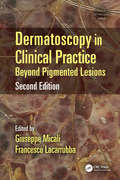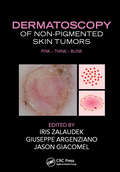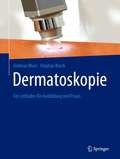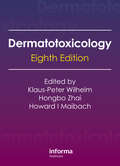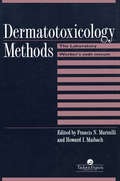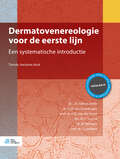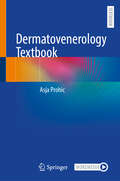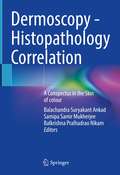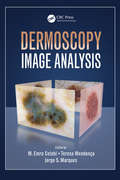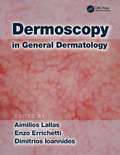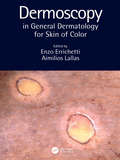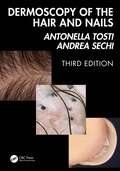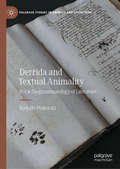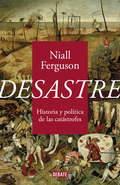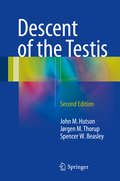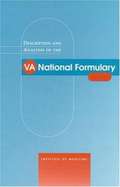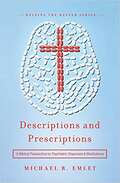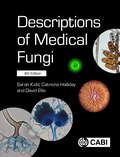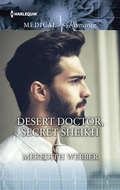- Table View
- List View
Dermatoscopy in Clinical Practice: Beyond Pigmented Lesions (Series in Dermatological Treatment)
by Giuseppe Micali Francesco LacarrubbaDermatoscopy has been heavily promoted to dermatologists as the front line in detecting skin cancer early and easily. However, this technology also has other uses in everyday dermatologic practice. Dermatoscopy in Clinical Practice shows those already using the equipment how they can extend its use beyond pigmented lesions and exploit its full potential. Dermatoscopy and videodermatoscopy can be used for differential diagnosis, prognostic evaluation, and monitoring response to treatment of various disorders including inflammatory diseases, parasitoses, viral and fungal infections, nonpigmented skin lesions, hair abnormalities, and a large variety of other dermatologic conditions as well as cosmetology. The book focuses on those conditions in which the techniques are most useful, describing the clinical and histopathological correlations associated with the procedure. The book includes color clinical images throughout, making it a handy guide for the dermatologist’s daily practice.
Dermatoscopy of Non-Pigmented Skin Tumors: Pink - Think - Blink
by Giuseppe Argenziano Iris Zalaudek Jason GiacomelAlthough many skin lesions are pigmented, Dermatoscopy of Non-pigmented Skin Tumors: Pink - Think - Blink addresses non-pigmented lesions, which may be more difficult to diagnose. It discusses dermatoscopy not only as a reliable tool for diagnosis, but also for the monitoring of treatment outcomes following topical therapy. <P><P>The clinical diagnosis of non-pigmented skin lesions is one of the most challenging in the daily routine. To arrive at a correct diagnosis—or at least an adequate management plan—the clinician needs to collect many pieces of information and put them together like a puzzle. Illustrated with nearly 200 color clinical and dermatoscopic photographs, this book is an invaluable guide for clinicians striving to solve the diagnostic puzzle and correctly identify non-pigmented lesions.
Dermatoses in Dark Vs Light Skin: Differing Clinical Manifestations
by Eckart Haneke Ranthilaka R. GammanpilaDiagnosis in dermatology is largely based on visual inspection of a lesion or a suspicious skin area; however, visual diagnosis and pattern recognition can vary according to patients’ skin types, and the disorders themselves can have markedly different presentation profiles in different skin colors. This book provides succinct information to identify the differing clinical manifestations of skin diseases in darker skin and lighter skin, discussing 130 skin conditions with high-quality color Illustrations, and will be an invaluable reference for even experienced professionals working on skin diseases in heterogeneous populations.
Dermatoskopie: Ein Leitfaden für Ausbildung und Praxis
by Andreas Blum Stephan BoschDie gesamte Bandbreite der Dermatoskopie wird in diesem praktischen Leitfaden didaktisch mit vielen Graphiken, Tabellen und dermatoskopischen Beispielen verständlich dargestellt. Somit kann die Anfängerin bzw. der Anfänger diese nicht-invasive diagnostische Methode von bös- und gutartigen Hauttumoren rasch erlernen. Fortgeschrittene können ihre Fähigkeiten anschaulich wiederholen und vertiefen. Der Praxisbezug beinhaltet zudem die Diagnostik von den gängigen Haar- und Nagelerkrankungen als auch von entzündlichen Hauterkrankungen.
Dermatotoxicology
by Howard I. Maibach Klaus-Peter Wilhelm Hongbo ZhaiThe foundational reference in dermal toxicology, this classic text has been completely revised to bring it up to date in the new Eighth Edition, with almost a third of its chapters being newly added. The structure of the text has also been reorganized to enable easier location of a topic of interest. With contributions from leading international ex
Dermatotoxicology Methods: The Laboratory Worker's Ready Reference
by Howard I. Maibach Francis N. MarzulliThis work presents and evaluates methods employed to identify the potential of certain types of chemicals to adversely affect the skin. A variety of test methods are included such as tests for skin penetration, metabolism, irritation, the skin immune system, photo effects, skin cancer, and topical effects of retinoids and depigmenting chemicals. Tests for chemicals that affect the reproductive and nervous system are also included. Both animal and human tests that have been standardised and tests that are under development and employ animal alternatives are addressed in this book. Besides different testing methods, a rationale for accepting non-animal models and a review of some regulatory agency discussions about animal alternative tests are included.
Dermatovenereologie voor de eerste lijn: Een systematische introductie
by H. E. Horst J.J.E. Everdingen J.H. Sillevis Smitt M. V. Starink M. Wintzen J. LambertIn Dermatovenereologie voor de eerste lijn wordt een uitgebreid en goed toegankelijk overzicht gegeven van de dermatologie en venereologie. Op basis van deze uitgave kan iedere medicus aan de hand van morfologische en topografische kenmerken van een aandoening op de huid en de aangrenzende slijmvliezen snel een differentiële diagnose stellen en zich een indruk vormen van de therapeutische mogelijkheden. Bij het Bespreken van de aandoening komen achtereenvolgens het klinisch beeld, het voorkomen, de pathofysiologie, de diagnostiek, de behandeling en eventueel het beloop en het moment van verwijzen aan de orde. Naast hoofdstukken over bijzondere aandachtsgebieden zoals psychodermatologie en fotodermatologie is er speciale aanacht voor dermatosen die voorkomen bij mensen in een bepaalde levensfase, zoals zwangere vrouwen, ouderen en kinderen. In deze achtste, geheel herziene druk van Dermatovenereologie voor de eerste lijn zijn vele nieuwe ontwikkelingen en inzichten opgenomen en is aandacht besteed aan het actualiseren van de referenties. Alle hoofdstukken zijn vernieuwd en geactualiseerd en er is een nieuw hoofdstuk over cosmetische dermatologie toegevoegd. De bijgevoegde cd-rom met fotomateriaal is niet alleen bedoeld ter illustratie van het boek, maar is tevens een uitstekend midden ziektebeelden nog beter te duiden. Bovendien vullen de teksten in het boek en op de cd-rom elkaar aan, waardoor zowel het boek als de cd-rom zich zeer goed lenen voor zelfstudie. Het uitgebreide register maakt het boek bij uitstek geschikt als naslagwerk.
Dermatovenerology Textbook
by Asja ProhicThis textbook provides comprehensive material for students and dermatology residents, as well as general practitioners and related professionals who desire a more robust knowledge in dermatolovenerology. The material is presented in a modern, clear, concise yet comprehensive manner, with abstract, keywords, key points, subject index and self-assessment flashcards to aid quick access to information and memorizing. Chapters are the result of a decade of teaching, richly illustrated with over 400 original clinical photos that facilitate the understanding of the contents. They are structured as lessons: diseases are described according to definition, etiopathogenesis, clinical picture, diagnostic methods, differential diagnosis (including non-Caucasian skin types) and modern therapy. The accompanying interactive Flashcards complete this excellent learning tool. Additional questions via app: Download the Springer Nature Flashcards app for free and use exclusive additional material to test your knowledge.
Dermoscopy - Histopathology Correlation: A Conspectus in the Skin of colour
by Balachandra Suryakant Ankad Samipa Samir Mukherjee Balkrishna Pralhadrao NikamThis atlas presents dermoscopic-histopathological correlations of dermatologic and pathological presentations seen in the Asian subcontinent. The disorders have been explained with the help of state of the art clinical, dermoscopic and pathological figures of various entities in skin of color. The format has been kept simple and easy to understand which is deciphered through dermoscopic and histopathological correlation. This title also emphasizes on atypical presentations and rare dermoscopic features with the help of thorough description covering clinical and pathological manifestations, diagnosis, and differential diagnosis.Written for dermatologists, dermato-pathologists, dermoscopists and residents of dermatology, this atlas is a detailed visual guide to effectively evaluate and diagnose various skin disorders.
Dermoscopy Image Analysis (Digital Imaging and Computer Vision)
by M. Emre Celebi Jorge S. Marques Teresa MendongaDermoscopy is a noninvasive skin imaging technique that uses optical magnification and either liquid immersion or cross-polarized lighting to make subsurface structures more easily visible when compared to conventional clinical images. It allows for the identification of dozens of morphological features that are particularly important in identifyin
Dermoscopy in General Dermatology
by Aimilios Lallas Enzo Errichetti Dimitrios IoannidesThis lavishly illustrated guide from experts will enable practitioners to get the most out of dermoscopy for investigations and treatments in general dermatology.
Dermoscopy in General Dermatology
by Aimilios Lallas, Enzo Errichetti and Dimitrios IoannidesThis lavishly illustrated guide from experts will enable practitioners to get the most out of dermoscopy for investigations and treatments in general dermatology.
Dermoscopy in General Dermatology for Skin of Color
by Msc Enzo Md, Msc Enzo Errichetti MSc Aimilios Md, MSc Aimilios LallasDermoscopy can be a useful tool to evaluate skin of color for general dermatologic diseases; however, it does require practitioners to be aware of many points of difference from patients with lighter phototypes. This highly illustrated text brings together the pioneering experience of international experts to document patients of phototypes IV to VI (from subcontinental Asian, North African, South American, to African skin).
Dermoscopy of the Hair and Nails
by Antonella TostiWhen the first edition of this pioneering text was published, only a few dermatologists were trained to utilize the dermatoscope for the diagnosis and follow-up of hair diseases. The technique is now more popular worldwide, prompting the development of this updated second edition, which now includes a section devoted entirely to nail dermoscopy and
Dermoscopy of the Hair and Nails 3e
by Antonella Tosti Andrea SechiThis new edition of a bestselling text almost amounts to a completely new book, with over 750 figures of common and uncommon disorders, including new chapters on trichoscopy of hair transplantation, teletrichoscopy, and trichoscopy of the shaved scalp. The chapters also list the key clues that are important to help the practitioner reach the correct diagnosis about problems with hair or nails."Numerous high-quality photos are helpful in demonstrating key features" (Doody’s Reviews) [of the previous edition]
Derrida and Textual Animality: For a Zoogrammatology of Literature (Palgrave Studies in Animals and Literature)
by Rodolfo PiskorskiDerrida and Textual Animality: For a Zoogrammatology of Literature analyses what has come to be known, in the Humanities, as ‘the question of the animal’, in relation to literary texts. Rodolfo Piskorski intervenes in the current debate regarding the non-human and its representation in literature, resisting popular materialist methodological approaches in the field by revisiting and revitalising the post-structuralist thought of Derrida and the ‘linguistic turn’. The book focuses on Derrida’s early work in order to frame deconstructive approaches to literature as necessary for a theory and practice of literary criticism that addresses the question of the animal, arguing that texts are like animals, and animals are like texts. While Derrida’s late writings have been embraced by animal studies scholars due to its overt focus on animality, ethics, and the non-human, Piskorski demonstrates the additional value of these early Derridean texts for the field of literary animal studies by proposing detailed zoogrammatological readings of texts by Freud, Clarice Lispector, Ted Hughes, and Darren Aronofsky, while in dialogue with thinkers such as Butler, Kristeva, Genette, Deleuze and Guattari, and Attridge.
Desastre: Historia y política de las catástrofes
by Niall FergusonUna historia de las catástrofes deslumbrante, original y repleta de ideas para el futuro que pone en perspectiva el ya conocido como annus horribilis. Los desastres son difíciles de prever, pero en la actualidad deberíamos estar mejor preparados contra las catástrofes que los romanos cuando el Vesubio entró en erupción o que los italianos cuando golpeó la Peste Negra en la Edad Media. Al fin y al cabo, nosotros contamos con la ciencia. Sin embargo, tal y como ha quedado demostrado con la crisis del coronavirus, la respuesta de la mayoría de países desarrollados ante un nuevo patógeno ha sido más bien torpe. ¿Cómo es posible? Niall Ferguson sostiene, entre muchas otras cosas, que estaban en juego patologías previas arraigadas ya visibles en nuestras respuestas a otros desastres del pasado. Desde diversas disciplinas, incluidas la economía y la ciencia de redes, Desastre ofrece no solo una historia,sino también una teoría general de los desastres, y expone cómo nuestros complejos y atrofiados sistemas de gobernanza son incapaces de afrontar las crisis. Como muestra Ferguson, los gobiernos deben aprender a ser menos burocráticos y más resilientes si quieren evitar un declive irreversible. La crítica ha dicho...«No se trata de un virus, sino de una colisión de política, pánico, medios digitales, comportamiento humano e incompetencia. Desastre analiza cada uno de estos aspectos, poniéndolos en perspectiva histórica en una obra de deslumbrante alcance y rigor.»The Spectator «Ferguson se vale de su prodigioso intelecto para situar la pandemia en un lienzo histórico más amplio.»Financial Times «Perspicaz, exhaustivo, provocador y francamente brillante.»The New York Times «Una historia magnífica sobre el olvidado arte de gestionar una crisis.»The Telegraph «Ferguson es el historiador más brillante de su generación. Su escritura es extraordinaria.»Time «Niall Ferguson sitúa la pandemia en la más amplia de las perspectivas históricas y nos recuerda que esta no es la primera vez que los seres humanos han tenido que lidiar con una catástrofe. Basándose en un profundo conocimiento de la historia global, cataloga las amenazas a las que se ha enfrentado la humanidad y las formas ingeniosas en que las sociedades humanas las han afrontado.»Francis Fukuyama «Los seres humanos tenemos tantas maneras posibles de sufrir un terrible desastre que uno pensaría que deberíamos haber desarrollado una mejor capacidad de respuesta. En su extenso, sintético y atractivo libro, este historiador maestro explica por qué no ha sido así y ofrece un camino a seguir para encontrar soluciones más seguras y sensatas la próxima vez que nos enfrentemos una catástrofe.»Nicholas A. Christakis
Descent of the Testis
by John M. Hutson Spencer W. Beasley Jørgen M. ThorupThis book provides a state of the art overview of all aspects of testicular descent and cryptorchidism, including the mechanisms of descent and the causes, consequences, diagnosis, and treatment of undescended testis. The advances in understanding that have been achieved over the past two decades are clearly explained, covering the latest genetic information on the causes of normal and abnormal testicular descent, the role of INSL3 in transabdominal migration, and the evidence that a neurotransmitter released from the genitofemoral nerve mediates androgenic control of inguinoscrotal descent. Exciting changes in the management of both congenital and acquired cryptorchidism, such as the widespread use of laparoscopy for impalpable testes inside the abdominal cavity, are fully described. Evidence for the benefits of orchidopexy within the first year of life is reviewed, and an individual chapter is also devoted to hormonal treatment. Throughout the book due attention is given to ongoing controversies and divergences of opinion. This new edition of Descent of the Testis will be a timely update and valuable reference for all who are involved in research into testicular descent and management of cryptorchidism.
Description and Analysis of the VA National Formulary
by Institute of MedicineThe National Academies Press (NAP)--publisher for the National Academies--publishes more than 200 books a year offering the most authoritative views, definitive information, and groundbreaking recommendations on a wide range of topics in science, engineering, and health. Our books are unique in that they are authored by the nation's leading experts in every scientific field.
Descriptions and Prescriptions: A Biblical Perspective on Psychiatric Diagnoses and Medications
by Michael R. EmletOCD, ADHD, PTSD, Bipolar Disorder . . . these are no longer just technical terms and medical diagnoses, they are part of our common vocabulary and culture. As Christians, we shouldn't isolate ourselves from this discussion or dismiss these important issues. But we also should be careful not to accept the entire secular psychiatric diagnostic and treatment enterprise without question. What we need is a balanced, biblically (and scientifically) informed approach that neither blindly accepts nor harshly dismisses psychiatric labels, diagnoses, and medicines that are prescribed to help those who are suffering. <P><P> As both a Biblical counselor and medical doctor, Michael R. Emlet, MD, gives readers a Christ-centered approach to psychiatry and guides both lay and professional helpers through the thicket of mental health labels and treatments with a biblical lens. In a clear and thoughtful way that puts the person experiencing mental health issues at the forefront, Emlet uses Scripture to show how the Bible engages in the discussion of psychiatric labels and the medications that are often recommended based on those labels. The first book in the Helping the Helper series, Descriptions and Prescriptions will give readers a biblical, gospel-formed perspective to help them understand and minister to those struggling with mental health issues.
Descriptions and Prescriptions: Values, Mental Disorders, and the DSMs
by John Z. SadlerMost everyone agrees that having pneumonia or a broken leg is always a bad thing, but not everyone agrees that sadness, grief, anxiety, or even hallucinations are always bad things. This fundamental disjunction in how disease and disorders are valued is the basis for the considerations in Descriptions and Prescriptions.In this book John Z. Sadler, M.D., brings together a distinguished group of contributors to examine how psychiatric diagnostic classifications are influenced by the values held by mental health professionals and the society in which they practice. The aim of the book, according to Sadler, is "to involve psychiatrists, psychologists, philosophers, and scholars in related fields in an intimate exchange about the role of values in shaping past and future classifications of mental disorders." Contributors: George J. Agich, Ph.D., Cleveland Clinic Foundation; Carol Berkenkotter, Ph.D., Michigan Technological University; Lee Anna Clark, Ph.D., University of Iowa; K.W.M. Fulford, D.Phil., F.R.C.Psych., University of Warwick, Coventry; Irving I. Gottesman, Ph.D., University of Virginia; Laura Lee Hall, Ph.D.; Cathy Leaker, Ph.D., Empire State College; Chris Mace, M.D., M.R.C.Psych., University of Warwick, Coventry; Laurie McQueen, M.S.S.W., American Psychiatric Association, Washington, D.C.; Christian Perring, Ph.D., Dowling College; James Phillips, M.D., Yale University School of Medicine; Harold Alan Pincus, M.D., University of Pittsburgh School of Medicine; Jennifer H. Radden, D.Phil., University of Massachusetts; Doris J. Ravotas, M.A., L.L.P., Michigan Technological University; Patricia A. Ross, Ph.D., University of Minnesota; Kenneth F. Schaffner, M.D., Ph.D., George Washington University; Michael Alan Schwartz, M.D., Case Western Reserve University; Daniel W. Shuman, J.D., Southern Methodist University; Allyson Skene, Ph.D., York University; Jerome C. Wakefield, D.S.W., Rutgers University; Thomas A. Widiger, Ph.D., University of Kentucky; Osborne P. Wiggins, Ph.D., University of Louisville.
Descriptions of Medical Fungi
by Dr Sarah Kidd Dr Catriona Halliday Professor David EllisThe 4th edition of this book provides laboratory staff and clinicians with a quick benchtop reference on the identification and antifungal susceptibility of human and animal fungal infections. It contains descriptions of all the major medical fungal pathogens, 179 species from 109 genera. This updated edition includes new and revised descriptions and he authors have reconciled current morphological descriptions and name changes with more recent genetic data. The most common fungal species are described, including members of the yeasts, mucoromycetes, conidial moulds, dimorphic pathogens, and dermatophytes. The book features: updates to taxonomy and fungal names. more than 350 colour photographs. antifungal susceptibility profiles, including for new drugs where available. methods of identification including molecular and/or MALDI-ToF mass spectroscopy. This handy reference is essential for laboratory staff and clinicians dealing with the identification and management of human and animal fungal infections, researchers in medical microbiology and mycology laboratories.
Desde la trinchera
by César CarballoLa verdad detrás de la pantalla: el médico que habló claro cuando todos callaban relata sus historias de vida tras veinte años en la trinchera de un box de Urgencias. «Siempre he creído que los médicos aprenden más de los errores que de los aciertos. Todos los médicos fallamos, somos humanos y los humanos se equivocan, así que creo que cada médico debe lidiar con sus fantasmas. Muchas veces me dicen que los médicos no reconocen sus errores. No sé si en público, pero les aseguro que nos persiguen el resto de nuestra vida. Abro la caja de mis fantasmas a menudo y converso al final de la noche con ellos, los considero mis hermanos y hermanas». Este libro es un acto de desnudez de un médico que lleva veinte años en primera línea. En estas 7 historias de vida que componen sus páginas traslucen la pasión por el trabajo y por los pacientes, la fe y la esperanza en la ciencia por encima de todo, pero también la oscuridad que alberga la enfermedad y el dolor que produce saber que a veces nada es suficiente. A través de ellas, el doctor César Carballo nos presenta casos de pacientes al límite, nos habla de cómo funciona nuestro cuerpo, nos muestra la fiereza de los sanitarios en situaciones extremas, nos revela las carencias y los fallos -los del sistema y los humanos-, los pequeños detalles que marcan la diferencia entre vivir o morir y los milagros -que también suceden- desde la trinchera de un box de Urgencias.
Desert Doctor, Secret Sheikh
by Meredith WebberThe desert prince's bride Dr Jenny Stapleton has devoted herself to those in need around the globe, risking her life but never her heart—she's done that before and lost it, along with her husband and her unborn child. In Zaheer she meets Dr Kam Rahman, a man she thinks is only a doctor—but actually he is a sheikh! Sheikh Kamid Rahman al'Kawali is heir to the throne of Zaheer! By travelling anonymously he can better address his country's needs, and he is struck by Jen's passion for his people—and the passion she arouses in him. He is soon to ascend the throne, and knows he wants this desert doctor as his queen!
Desert Malaria: An Emerging Malaria Paradigm and Its Global Impact on Disease Elimination
by B.K. TyagiThis book comprehensively reviews the disease dynamics, distribution, surveillance, epidemiology, diagnosis, control strategies, and management of the desert malaria. It highlights the potential risks of unstable but often exacerbated malaria conflagration as epidemics in the middle of duned desert, a desert oasis, and desert-fringe regions. Further, it reveals the factors inveigled into desert environments due to extensive anthropogenic activities such as canalized irrigation projects, high-yielding new agriculture practices, human concentration, and increased trade. It addresses the impact of irrigation on the malarial dynamics and its coupling to the climate forcing. The book also offers a model for desert transformation into malaria heaven under the changed climatic conditions including high rainfall, humidity, and depletion in temperature. Lastly, it offers insight into malaria epidemiology and disease control in the desert’s arid environments. This book is an essential resource for medical entomologists, parasitologists, epidemiologists, and public health researchers.
